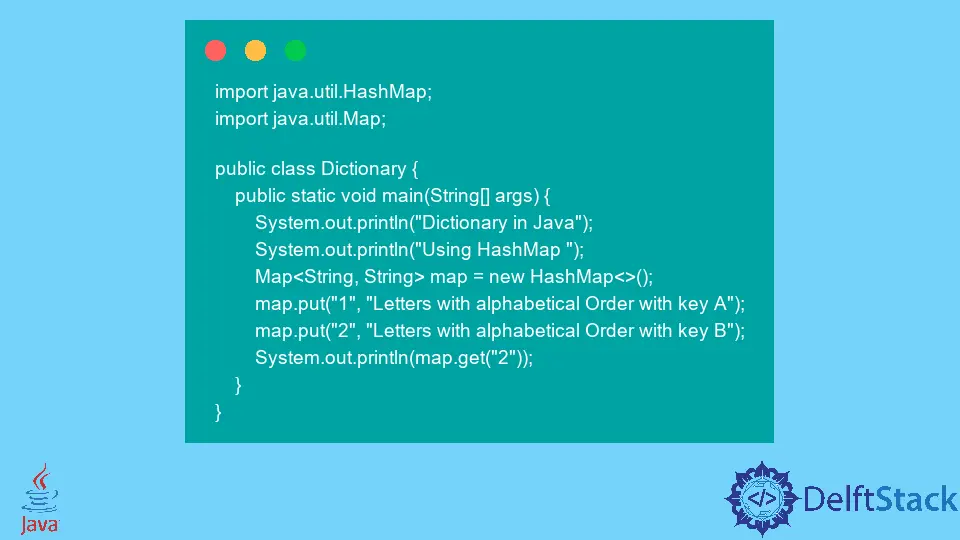Java Dictionary

In Java language, the Dictionary gets represented using a data structure called the Map interface. The Map data structure gets used to present data in key-value pairs. The Map is an interface that keeps track of all the keys and the corresponding values. A user can retrieve the value based on a unique key. The Map interface holds the following properties:
- All the keys present in the
Mapare unique. - There can be a unique key corresponding to one or more values.
- Keys are the entities that are non-null.
Below is the code block demonstrating the use of a dictionary or Map in Java language.
import java.util.HashMap;
import java.util.Map;
public class Dictionary {
public static void main(String[] args) {
System.out.println("Dictionary in Java");
System.out.println("Using HashMap ");
Map<String, String> map = new HashMap<>();
map.put("1", "Letters with alphabetical Order with key A");
map.put("2", "Letters with alphabetical Order with key B");
System.out.println(map.get("2"));
}
}
The Map is an interface present separately, apart from the Collection framework hierarchy.
The Map is present in the java.util package and shows how a key gets mapped to the values. There can be multiple implementations to a map, that are:
HashMapLinkedHashMapHashtable
The usage of each can vary based on the users’ needs for the implementation.
In the above code snippet, the HashMap implementation gets used. It is the default and widely used class in the Java Language. The difference between all three types is defined below.
HashMap is introduced in Java 1.2 version, whereas Hashtable is a legacy class. It is thread-safe, and hence concurrent operations are allowed among multiple threads, maintaining consistency in the code. But the HashMap’s is not thread-safe and allows no concurrency.
Due to the thread-safe nature of HashMap, it is faster in performance than the Hashtable. Additionally, HashMap is fail-fast and throws ConcurrencyException when its instance gets manipulated by multiple threads at a time. In contrast to it, Hashtable seems fail-safe. The use case of LinkedHashMap resides when a user wants to save the insertion order.
The Map instance gets created using the HashMap class in the code block above. The operations like get and put are used to store and retrieve the specific values from the instance. The put method takes two parameters that are the key and its value.
Internally, the key gets first evaluated if it is present in the map object using the containsKey() function. If it evaluates to true, then the current value of the key is replaced with the new value. The method throws UnsupportedOperationException if the defined operation gets not supported by the Map with the given key.
The ClassCastException if key or value prevents the key from storing, NullPointerException if the specified key or value is null and the Map does not permit null keys or values. IllegalArgumentException if some property of the key or value prevents it from being stored in the Map.
Once the key gets inserted into the Map, it gets retrieved using the get function. The get function takes a single parameter that is the unique key. It throws ClassCastException and NullPointerException when the key is inappropriate or if the specified key is null.
Below is the output of the map interface using the HashMap class.
Dictionary in Java Using HashMap Letters with alphabetical Order with key B
Rashmi is a professional Software Developer with hands on over varied tech stack. She has been working on Java, Springboot, Microservices, Typescript, MySQL, Graphql and more. She loves to spread knowledge via her writings. She is keen taking up new things and adopt in her career.
LinkedIn